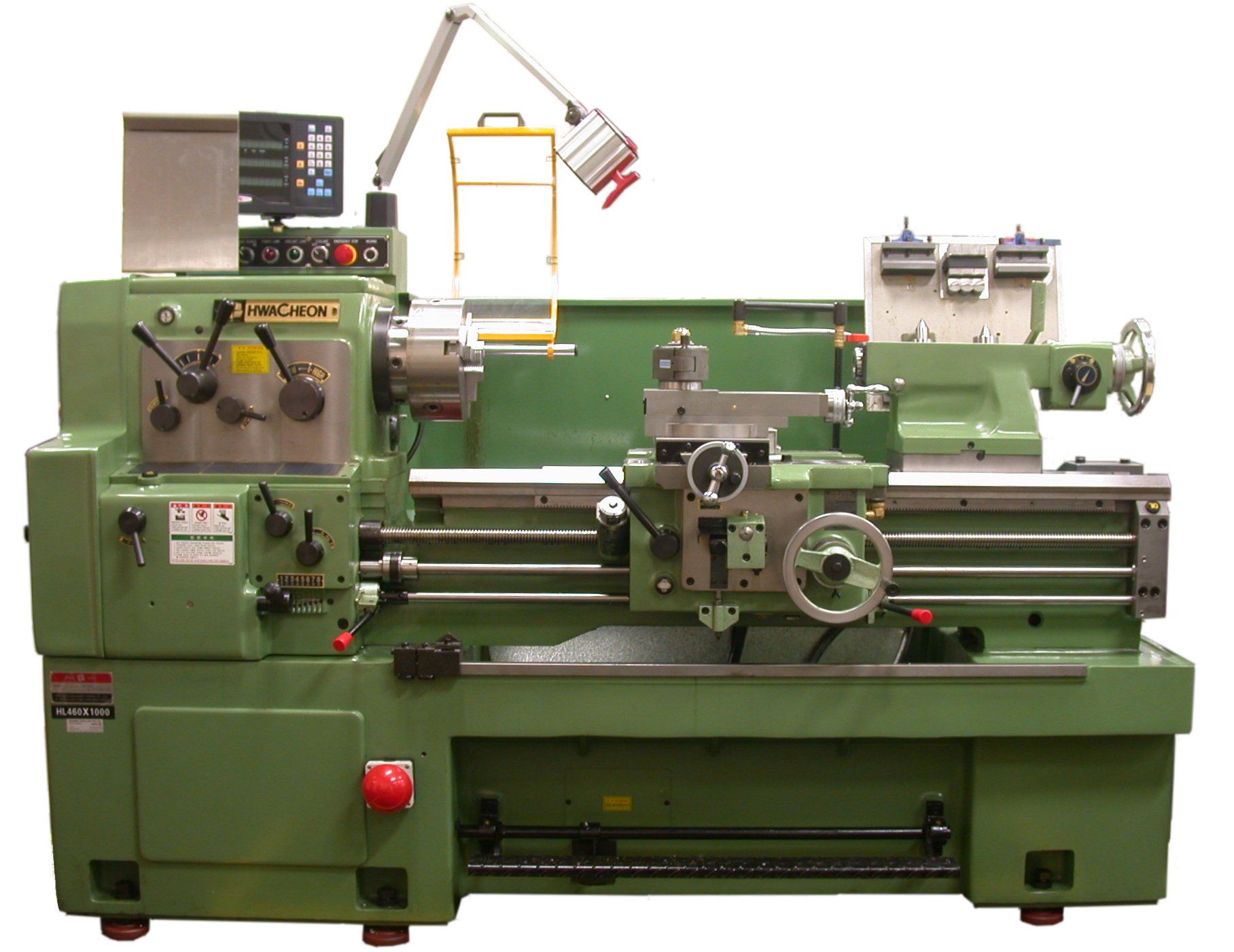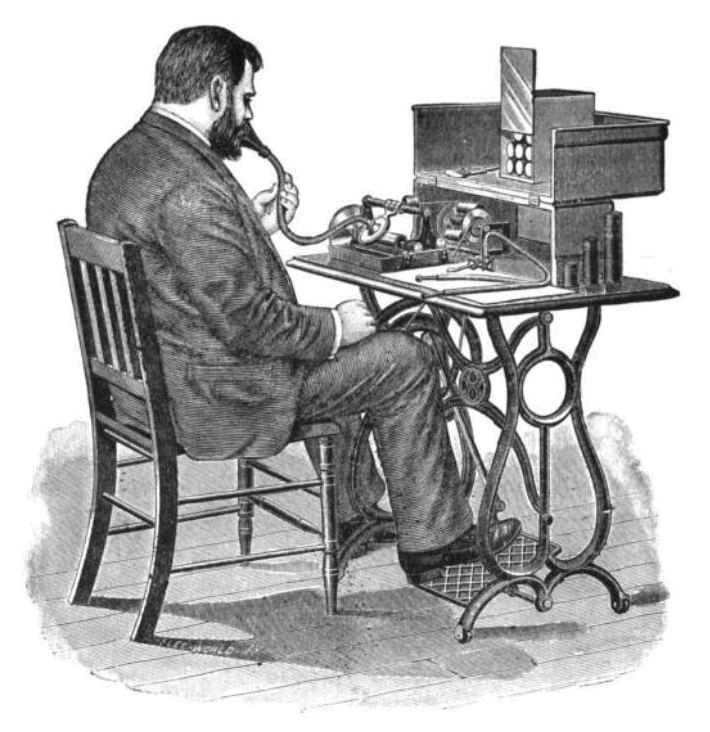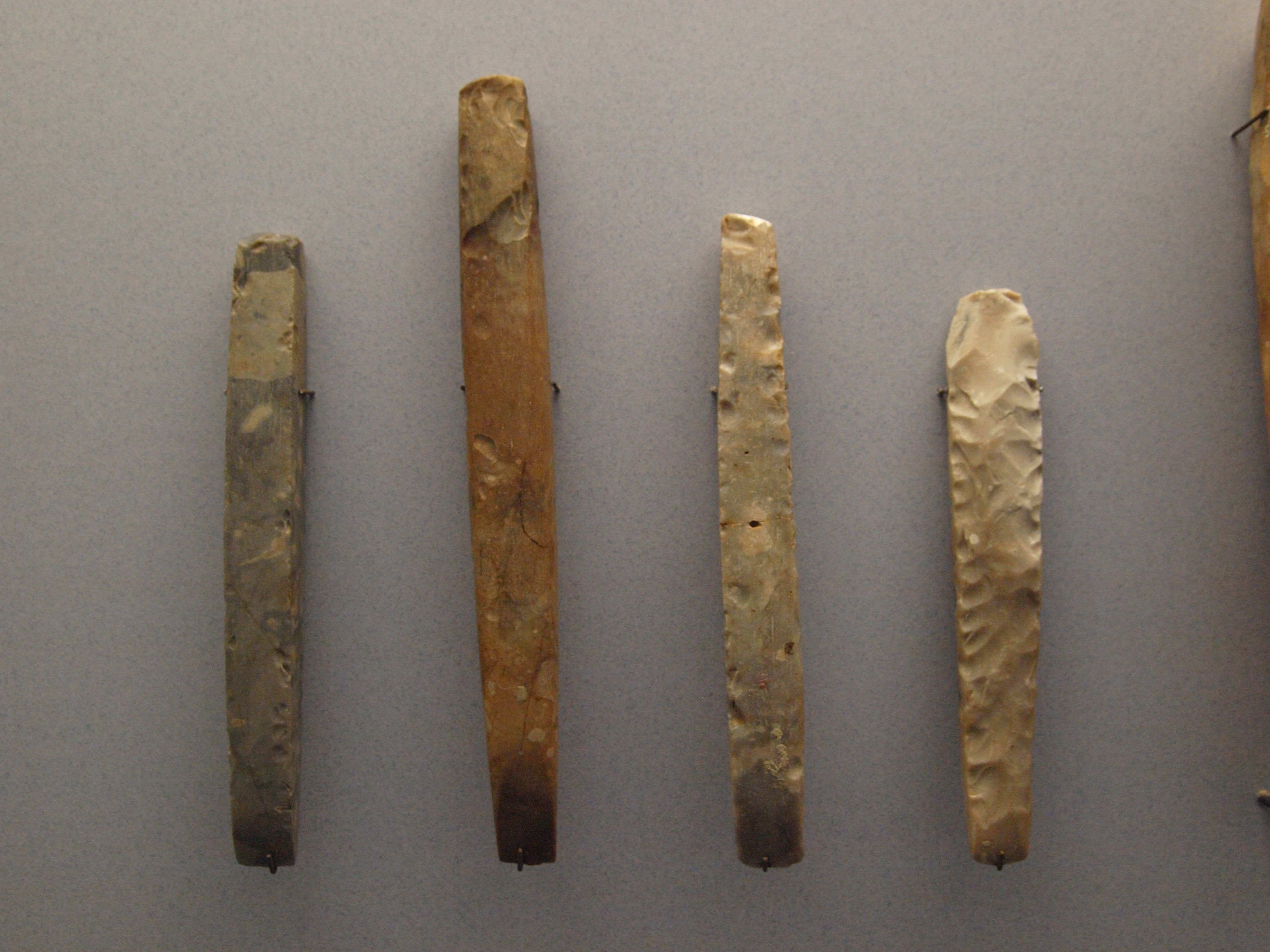|
Pole Lathe
A pole lathe, also known as a springpole lathe, is a wood-turning lathe that uses the resilience of a long pole as a return spring for a treadle. Pressing the treadle pulls on a cord that is wrapped around the piece of wood or billet being turned. The other end of the cord reaches up to the end of a long springy pole. As the action is reciprocating, the work rotates in one direction and then back the other way. Cutting is only carried out on the down stroke of the treadle, the spring of the pole only being sufficient to return the treadle to the raised position ready for the next down stroke. Bungee cords are sometimes used as a modern replacement for springpoles. A bungee cord can function within a smaller space but the pole lathe still rotates in two directions and cutting is only possible on the downstroke. While the action of the pole lathe and the skills required are similar to those employed on a modern power lathe, the timber used on a pole lathe is usually freshly felled a ... [...More Info...] [...Related Items...] OR: [Wikipedia] [Google] [Baidu] |
Lathe
A lathe () is a machine tool that rotates a workpiece about an axis of rotation to perform various operations such as cutting, sanding, knurling, drilling, deformation, facing, threading and turning, with tools that are applied to the workpiece to create an object with symmetry about that axis. Lathes are used in woodturning, metalworking, metal spinning, thermal spraying, reclamation, and glass-working. Lathes can be used to shape pottery, the best-known design being the Potter's wheel. Most suitably equipped metalworking lathes can also be used to produce most solids of revolution, plane surfaces and screw threads or helices. Ornamental lathes can produce three-dimensional solids of incredible complexity. The workpiece is usually held in place by either one or two ''centers'', at least one of which can typically be moved horizontally to accommodate varying workpiece lengths. Other work-holding methods include clamping the work about the axis of rotation using a ... [...More Info...] [...Related Items...] OR: [Wikipedia] [Google] [Baidu] |
Treadle
A treadle (from , "to tread") is a foot-powered lever mechanism; it is operated by treading on it repeatedly. A treadle, unlike some other types of pedals, is not directly mounted on the crank (see treadle bicycle for a clear example). Most treadle machines convert reciprocating motion into rotating motion, using a mechanical linkage to indirectly connect one or two treadles to a crank. The treadle then turns the crank, which powers the machine. Other machines use treadles directly, to generate reciprocating motion. For instance, in a treadle loom, the reciprocating motion is used directly to lift and lower the harnesses or heddles; a common treadle pump uses the reciprocating motion to raise and lower pistons. Before the widespread availability of electric power, treadles were the most common way to power a range of machines. They are still widely used as a matter of preference and necessity. A human-powered machine gives the human operator close, instinctive control ov ... [...More Info...] [...Related Items...] OR: [Wikipedia] [Google] [Baidu] |
Woodturning
Woodturning is the craft of using a wood lathe with hand-held tools to cut a shape that is symmetrical around the axis of rotation. Like the potter's wheel, the wood lathe is a mechanism that can generate a variety of forms. The operator is known as a ''turner'', and the skills needed to use the tools were traditionally known as ''turnery''. In pre-industrial England, these skills were sufficiently difficult to be known as "the mysteries of the turners' guild." The skills to use the tools by hand, without a fixed point of contact with the wood, distinguish woodturning and the wood lathe from the machinist's lathe, or metal-working lathe. Items made on the lathe include tool handles, candlesticks, egg cups, knobs, lamps, rolling pins, cylindrical boxes, Christmas ornaments, bodkins, knitting needles, needle cases, thimbles, pens, chessmen, spinning tops; legs, spindles, and pegs for furniture; balusters and newel posts for architecture; baseball bats, hollow forms such a ... [...More Info...] [...Related Items...] OR: [Wikipedia] [Google] [Baidu] |
National Trust For Places Of Historic Interest Or Natural Beauty
The National Trust () is a heritage and nature conservation charity and membership organisation in England, Wales and Northern Ireland. The Trust was founded in 1895 by Octavia Hill, Sir Robert Hunter and Hardwicke Rawnsley to "promote the permanent preservation for the benefit of the Nation of lands and tenements (including buildings) of beauty or historic interest". It has since been given statutory powers, starting with the National Trust Act 1907. Historically, the Trust acquired land by gift and sometimes by public subscription and appeal, but after World War II the loss of country houses resulted in many such properties being acquired either by gift from the former owners or through the National Land Fund. One of the largest landowners in the United Kingdom, the Trust owns almost of land and of coast. Its properties include more than 500 historic houses, castles, archaeological and industrial monuments, gardens, parks, and nature reserves. Most properties are open ... [...More Info...] [...Related Items...] OR: [Wikipedia] [Google] [Baidu] |
Chisel
A chisel is a hand tool with a characteristic Wedge, wedge-shaped cutting edge on the end of its blade. A chisel is useful for carving or cutting a hard material such as woodworking, wood, lapidary, stone, or metalworking, metal. Using a chisel involves forcing the blade into some material to cut it. The driving force may be applied by pushing by hand, or by using a mallet or hammer. In industrial use, a hydraulic ram or falling weight ('trip hammer') may be used to drive a chisel into the material. A Chisel#Gouge, gouge is a type of chisel that serves to carve small pieces from the material; particularly in woodworking, woodturning and sculpture. Woodworking Woodworking chisels range from small hand tools for tiny details, to large chisels used to remove big sections of wood, in 'roughing out' the shape of a pattern or design. Typically, in Wood carving, woodcarving, one starts with a larger tool, and gradually progresses to smaller tools to finish the detail. One of t ... [...More Info...] [...Related Items...] OR: [Wikipedia] [Google] [Baidu] |
Viking
Vikings were seafaring people originally from Scandinavia (present-day Denmark, Norway, and Sweden), who from the late 8th to the late 11th centuries raided, pirated, traded, and settled throughout parts of Europe.Roesdahl, pp. 9–22. They also voyaged as far as the Mediterranean Sea, Mediterranean, North Africa, the Middle East, Greenland, and Vinland (present-day Newfoundland in Canada, North America). In their countries of origin, and some of the countries they raided and settled in, this period is popularly known as the Viking Age, and the term "Viking" also commonly includes the inhabitants of the Scandinavian homelands as a whole. The Vikings had a profound impact on the Early Middle Ages, early medieval history of Northern Europe, northern and Eastern Europe, including the political and social development of England (and the English language) and parts of France, and established the embryo of Russia in Kievan Rus'. Expert sailors and navigators of their cha ... [...More Info...] [...Related Items...] OR: [Wikipedia] [Google] [Baidu] |
Jórvík
Scandinavian York or Viking York () is a term used by historians for what is now Yorkshire during the period of Scandinavian domination from late 9th century until it was annexed and integrated into England after the Norman Conquest; in particular, it is used to refer to York, the city controlled by these kings and earls. The Kingdom of Jórvík was closely associated with the longer-lived Kingdom of Dublin throughout this period. History Pre-Viking age York was first recorded by Ptolemy around the year 150 as ''Eborakon''. Under the Romans it became the provincial capital and bishopric of ''Eburacum''. The Roman settlement was regularly planned, well defended and contained a stone legionary fortress. The Romans withdrew around 407 and the Anglo-Saxons occupied the settlement from the early 7th century. Post-Roman York was in the kingdom of Deira; it was taken over in 655 by its northern neighbour Bernicia to form the kingdom of Northumbria. The Anglo-Saxon king Edwin o ... [...More Info...] [...Related Items...] OR: [Wikipedia] [Google] [Baidu] |
York
York is a cathedral city in North Yorkshire, England, with Roman Britain, Roman origins, sited at the confluence of the rivers River Ouse, Yorkshire, Ouse and River Foss, Foss. It has many historic buildings and other structures, such as a York Minster, minster, York Castle, castle and York city walls, city walls, all of which are Listed building, Grade I listed. It is the largest settlement and the administrative centre of the wider City of York district. It is located north-east of Leeds, south of Newcastle upon Tyne and north of London. York's built-up area had a recorded population of 141,685 at the 2021 United Kingdom census, 2021 census. The city was founded under the name of Eboracum in AD 71. It then became the capital of Britannia Inferior, a province of the Roman Empire, and was later the capital of the kingdoms of Deira, Northumbria and Jórvík, Scandinavian York. In the England in the Middle Ages, Middle Ages it became the Province of York, northern England ... [...More Info...] [...Related Items...] OR: [Wikipedia] [Google] [Baidu] |
Green Woodworking
Green woodworking (also written greenwoodworking) is a form of woodworking that uses unseasoned or "green" timber. The term "unseasoned" refers to wood that has been freshly felled or preserved by storing it in a water-filled trough or pond to maintain its naturally high moisture content. This wood is much softer than seasoned timber and is therefore much easier to shape with hand tools. As moisture leaves the unseasoned wood, shrinkage occurs. This can be used as an advantage, as this shrinkage can help ensure tight joints. To enhance the effect of the shrinkage, a half of a joint may be forcibly over-dried in a simple kiln while its encapsulating component is left green. The components tighten against each other as the parts exchange moisture and approach equilibrium with the surrounding environment. The swelling of the dry tenon inside the shrinking “green” mortise makes for an incredibly tight and permanent joint despite a lack of adhesives. Bodging is a traditional green wo ... [...More Info...] [...Related Items...] OR: [Wikipedia] [Google] [Baidu] |
Bodging
Bodging (full name chair-bodgering) is a traditional woodturning craft, using Green woodworking, green (unseasoned) wood to make chair legs and other cylindrical parts of chairs. The work was done close to where a tree was felled. The itinerant craftsman who made the chair legs was known as a bodger or chair-bodger. According to Collins Dictionary, the use of the term bodger in reference to green woodworking appeared between 1799 and 1827 and, to a much lesser extent, from 1877 to 1886 and from 1939 to present. History The term was once common around the furniture-making town of High Wycombe in Buckinghamshire, England. Traditionally, bodgers were highly skilled wood-turners, who worked in the beech woods of the Chiltern Hills. The term and trade also spread to Ireland and Scotland. Chairs were made and parts turned in all parts of the UK before the semi industrialised production of High Wycombe. As well recorded in Cotton the English Regional Chair. Bodgers also sold their was ... [...More Info...] [...Related Items...] OR: [Wikipedia] [Google] [Baidu] |
Philip Clissett
Philip Clissett (born 8 January 1817, Birtsmorton, Worcestershire, England; died 17 January 1913, Bosbury, Herefordshire) was a Victorian country chairmaker who influenced and inspired the English Arts and Crafts Movement through various architects and designers. His chance meeting with James MacLaren has been described as "undoubtedly a seminal point in the subsequent development of the Arts and Crafts Movement", and led to the furnishing of the meeting room of the Art Workers Guild with a large number of his chairs which can still be seen today. These chairs have been "highly influential", having been "seen by almost everyone involved in art and design from the late 1880s". They particularly influenced Ernest Gimson who, in 1890, spent six weeks with Clissett learning to make ladderback chairs. Clissett's chairs were popular with the Arts and Crafts cognoscenti, and were used by Charles Rennie Mackintosh in early commissions, and by the architectural team of Richard Barry ... [...More Info...] [...Related Items...] OR: [Wikipedia] [Google] [Baidu] |






